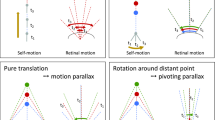Abstract
The flight torque responses of tethered flying houseflies to motion and presentation or removal of a vertical dark stripe on a bright background were recorded in real time. Motion with constant speed of 100° s-1 from front to back elicits a strong fast response following the diraction of the stimulus motion. Motion from back to front elicits a weaker response. Instantaneous presentation and removal of a stationary stripe elicit weak, slow response. Apparent motion from front to back and from back to front elicit weak responses with a fast, directionally selective, transient peak followed by a slow response component oriented towards the stripes position. The fast transient peak response is not elicited if the animals were stimulated before with real movement of the stripe. The results are discussed and an earlier proposed model for free flight tracking and fixation is extended.
Similar content being viewed by others
References
Beersma, D.G.M., Stavenga, D.G., Kuiper, J.W.: Organization of visual axes in the compound eye of the fly Musca domestica L., and behavioural consequences. J. Comp. Physiol. 102, 305–320 (1975)
Braitenberg, V.: Periodic structure and structural gradients in the visual ganglia of the fly. In: Information processing in the visual system of arthropods. Wehner, R. (ed.), pp. 3–15. Berlin, Heidelberg, New York: Springer 1972
Buchner, E.: Dunkelanregung des stationären Flugs der Fruchtfliege Drosophila. Diplomarbeit, Julius-Maximilans-Universität Würzburg, 1971
Collett, T.S.: Some operating rules for the optomotor system of a hoverfly during voluntary flight. J. Comp. Physiol. 138, 271–282 (1980)
Collett, T.S.: Angular tracking and the optomotor response. An analysis of visual reflex interaction in a hoverfly. J. Comp. Physiol. (in press)
Fermi, G., Reichardt, W.: Optomotorische Reaktion der Fliege Musca domestica. Kybernetik 2, 15–28 (1963)
Franceschini, N., Kirschfeld, K.: Les phenomenes de pseudopupille dans l'oeil compose de Drosophila. Kybernetik 9, 159–182 (1971)
Geiger, G.: Optomotor responses of the fly Musca d. to transient stimuli of edges and stripes. Kybernetik 16, 37–43 (1974)
Geiger, G.: Is there an independent position computation of an object in the fly's visual system? Biol. Cybern. (1981) (in press)
Geiger, G., Poggio, T.: The orientation of flies towards visual patterns: On the search for the underlying functional interactions. Biol. Cybern. 19, 39–54 (1975)
Götz, K.G.: Flight control in Drosophila by visual perception of motion. Kybernetik 4, 199–208 (1968)
Hausen, K., Wolburg-Buchholz, K., Ribi, W.A.: The synaptic organization of visual interneurons in the lobula complex of flies. Cell Tissue Res. 208, 371–387 (1980)
Hausen, K., Wehrhahn, C.: The role of horizontal cells in the visually induced yaw torque response. (in preparation)
Hauser, H.: Vergleichend quantitative Untersuchungen an den Sehganglien der Fliegen Musca d. und Drosophila m., Dissertation. Eberhard-Karls-Universität, Tübingen 1975
Land, M.F., Collett, T.S.: Chasing behaviour of houseflies (Fannia canicularis). J. Comp. Physiol. 89, 331–357 (1974)
McCann, G.D., MacGinitie, G.F.: Optomotor response studies of insect vision. Proc. R. Soc. (London) B. 163, 369–401 (1965)
Pick, B.: Visual flicker induces orientation behaviour in the fly Musca. Z. Naturforsch. 29c, 310–312 (1974)
Poggio, T., Reichardt, W.: A theory of the pattern induced flight orientation of the fly Musca domestica. Kybernetik 12, 185–203 (1973a)
Poggio, T., Reichardt, W.: Considerations on models of movement detection. Kybernetik 13, 223–227 (1973b)
Poggio, T., Reichardt, W.: Visual control of orientation behaviour in the fly. Part II. Towards the underlying neural interactions. Q. Rev. Biophys. 9, 377–438 (1976)
Poggio, T., Reichardt, W.: Visual fixation and tracking by flies: Mathematical properties of simple control systems. Biol. Cybern. (in press)
Reichardt, W.: The insect eye as a model for analysis of uptake, transduction and processing of optical data in the nervous system. In: The neurosciences: Second study program. Schmitt, F.O. (ed.). New York: Rockeffeller University Press 1970
Reichardt, W.: Musterinduzierte Flugorientierung. Naturwissenschaften 60, 122–138 (1973)
Reichardt, W.: Functional characterization of neural interactions through an analysis of behaviour. In: The neurosciences, fourth study program. Schmitt, F.O., Worden, F.G. (eds.), p. 81, Cambridge, MA, London: MIT Press 1979
Reichardt, W., Poggio, T.: Visual control of orientation behaviour in the fly. Part I. A quantitative analysis. Q. Rev. Biophys. 9, 311–375 (1976)
Srinivasan, M.V., Bernard, G.D.: The pursuit response of the housefly and its interaction with the optomotor response. J. Comp. Physiol. 115, 101–117 (1977)
Strausfeld, N.J.: Mosaic organizations, layers and visual pathways in the insect brain. In: Neural principles in vision. Zettler, F., Weiler, R. (eds.). Berlin, Heidelberg, New York: Springer 1976
Torre, V., Poggio, T.: A synaptic mechanism possibly underlying directional selectivity to motion. Proc. R. Soc. (London) B. 202, 409–416 (1978)
Virsik, R.: Verhaltens-Studie der visuellen Detektion und Fixierung bewegter Objekte durch die Fliege Musca domestica. Dissertation. Eberhard-Karls-Universität Tübingen, 1974
Wehrhahn, C.: Flight torque and lift responses of the housefly (Musca domestica) to a single stripe moving in different parts of the visual field. Biol. Cybern. 29, 237–247 (1978)
Wehrhahn, C.: Sex-specific differences in the chasing behaviour of houseflies (Musca). Biol. Cybern. 32, 239–241 (1979)
Wehrhahn, C., Hausen, K.: How is tracking and fixation accomplished in the nervous system of the fly. Biol. Cybern. 38, 179–187 (1980)
Zimmermann, G.: Der Einfluß stehender und bewegter Musteranteile auf die optomotorische Reaktion der Fruchtfliege Drosophila. Dissertation, Eberhard-Karls-Universität, Tübingen (1973)
Author information
Authors and Affiliations
Rights and permissions
About this article
Cite this article
Wehrhahn, C. Fast and slow flight torque responses in flies and their possible role in visual orientation behaviour. Biol. Cybern. 40, 213–221 (1981). https://doi.org/10.1007/BF00453371
Received:
Issue Date:
DOI: https://doi.org/10.1007/BF00453371




